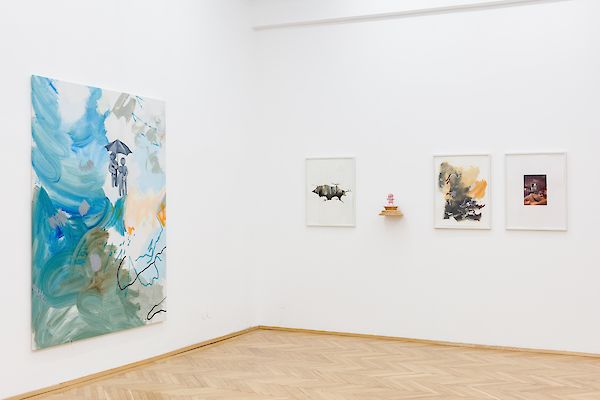Halvor Rønning
There are five books on a desk. One book is an inquiry into gambling addiction and the design of casinos and slot machines. Then, there is a recent translation of four plays by Euripides, and a third one, a scrutinized presentation of the male body in everyday life from 50’s Hollywood until today. The fourth takes us through the history of social class in the United States and how the land was colonized by a population of “waste people”, “lazy lubbers” and “crackers”. The last and final one is a historical overview of suicide, a reflection of the exclusive human capacity of being able to choose life or death.
Looking at these five books, the mind moves quickly from one to the other. The connection is where the thinking happens, and this so called “connection”, an accidental act of free association, is where things suddenly exhilarate. It is through this specific transformative mode that one can forget about everything, maybe feeling impermanent whilst stopping the mental back and forth of thesis, antithesis and summary.
A precondition for the work is that it has a shape that was not known when starting out. Its accuracy is made through an abstract element softly introduced to make any narrative unlinear. The structure of unanswerable questions is created in order to occupy the mind while dealing with reality. Once the work has its shape, it’s thrown into a vacuum, so we can stop, recline and watch. Is this Hell? With a lack of summary there is also no answer. What does an answer answer, anyway?
H.F.F.
Halvor Rønning (*1984 in Bergen, NO) lives and works in Oslo, NO.

Halvor Rønning, Hell, Recline, 2019, Installation view, FELIX GAUDLITZ, Vienna

Halvor Rønning, Hell, Recline, 2019, Installation view, FELIX GAUDLITZ, Vienna

Halvor Rønning, Hell, Recline, 2019, Installation view, FELIX GAUDLITZ, Vienna

Halvor Rønning, Ground Hole, 2019, Watercolor on paper, 65 × 50 cm (25.591 × 19.685 in)

Halvor Rønning, von Natur aus Charakter, 2019, Mixed Media, ca. 22,5 × 24,5 × 20,5 cm (8.858 × 9.646 × 8.071 in)

Halvor Rønning, von Natur aus Charakter, 2019 (Detail), Mixed Media, ca. 22,5 × 24,5 × 20,5 cm (8.858 × 9.646 × 8.071 in)

Halvor Rønning, Untitled, 2019, Acrylic, ink and gouache on paper, 65 × 50 cm (25.591 × 19.685 in)

Halvor Rønning, Untitled, 2019, Ink, magazine cut out and glue on paper, 65 × 50 cm (25.591 × 19.685 in)

Halvor Rønning, Hell, Recline, 2019, Installation view, FELIX GAUDLITZ, Vienna

Halvor Rønning, Poltrona, 2019, Ink and watercolor on paper, 65 × 50 cm (25.591 × 19.685 in)

Halvor Rønning, Poltrona, 2019, Ink on paper, 65 × 50 cm (25.591 × 19.685 in)

Halvor Rønning, Hell, Recline, 2019, Installation view, FELIX GAUDLITZ, Vienna

Halvor Rønning, Hell, Recline, 2019, Installation view, FELIX GAUDLITZ, Vienna

Halvor Rønning, Hell, Recline, 2019, Installation view, FELIX GAUDLITZ, Vienna

Halvor Rønning, Untitled, 2019, Acrylic and oil on canvas, 190 × 148 cm (74.803 × 58.268 in)

Halvor Rønning, Relax in Famiglia, 2019, Acrylic, ink and oil on canvas, 190 × 148 cm (74.803 × 58.268 in)

Halvor Rønning, Hell, Recline, 2019, Installation view, FELIX GAUDLITZ, Vienna

Halvor Rønning, Hell, Recline, 2019, Installation view, FELIX GAUDLITZ, Vienna

Halvor Rønning, Hell, Recline, 2019, Installation view, FELIX GAUDLITZ, Vienna

Halvor Rønning, Untitled, 2019, Acrylic, oil and ink on canvas, 190 × 148 cm (74.803 × 58.268 in)

Halvor Rønning, Hell, Recline, 2019, Installation view, FELIX GAUDLITZ, Vienna
Photography: kunst-dokumentation.com